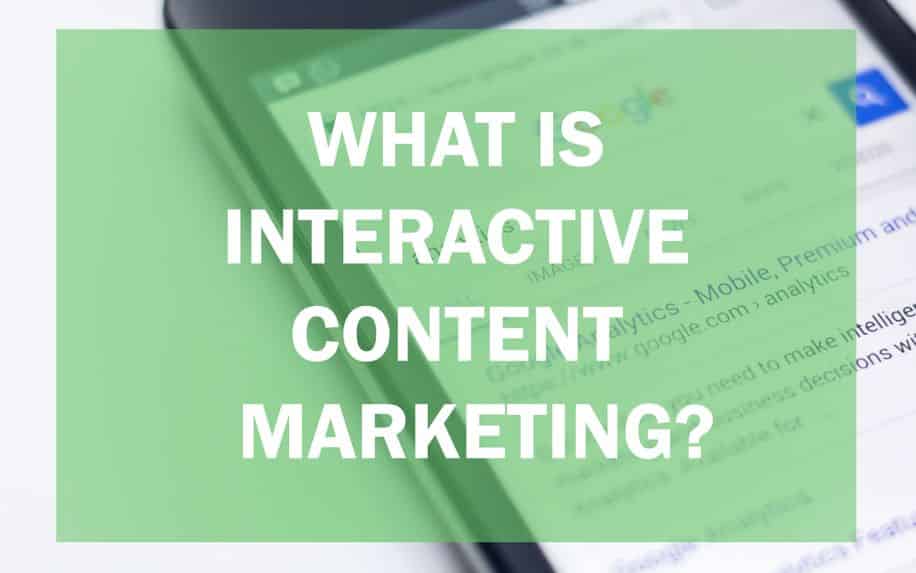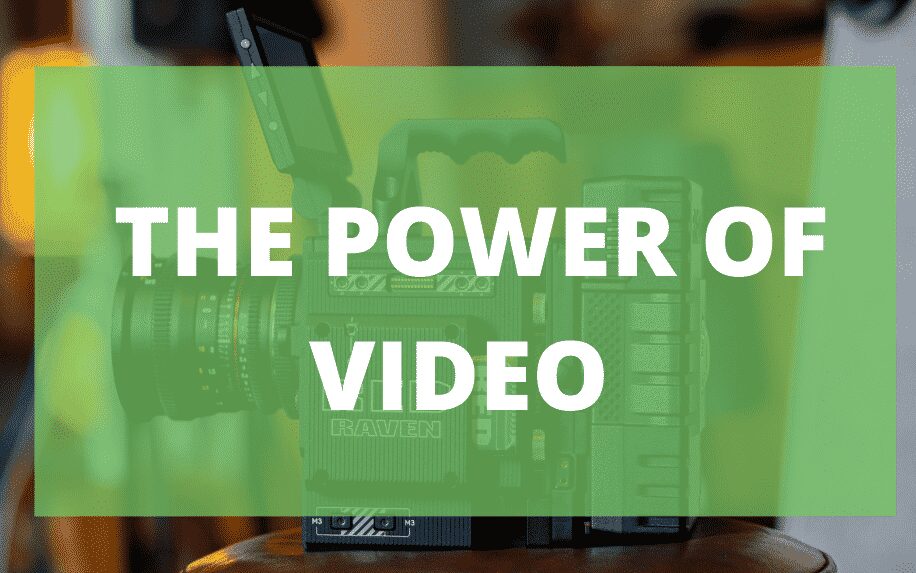What is interactive content marketing? In a nutshell, it is content that encourages the active engagement of your target audience by prompting them to take a certain action.
The world of marketing is based on competing messages and rival brands, each vying for the attention of the millions of consumers who browse the web every single day.
In a world so saturated with graphics, texts and videos, truly engaging your target audience with unique and engaging content is becoming more and more challenging.
Essentially, interactive content marketing is similar to a conversation – but one which you don’t have to participate in actively. This comes in a huge range of formats, and a lot of them are much simpler than you think.
Table of Contents
Why is Interactive Content Marketing so Important?
Gone are the days when simple textual messaging and creative graphics were sufficient. Consumers now prefer a more collaborative approach that actually values their individual feedback and participation.

Interactive content marketing serves its purpose better than any other form of marketing out there. It is one of the most engaging forms of digital content available, particularly because of the need for an audience’s undivided attention.
Think about more traditional forms of advertising, such as radio broadcasting, television, posters, billboards and fliers. All of these marketing methods require the most basic level of interactivity – and research demonstrates that most of us tend to throw these materials in the next bin we find.

Interactive Content is the Future of Marketing
Every so often, we see a new trend that the world of marketing immediately absorbs, holding it up as ‘revolutionary’ or the ‘future of marketing’. However, it is important to remember that best marketing practice is in a constant state of change.
There have been some really big developments and advancements in technology, such as the continued advancement of voice recognition and voice assisted technology.
This has transformed how we search for our favourite brands, and Search Engine Optimisation (SEO) as an industry is now scrambling to adapt to the technology.
Interactive content generates up to five times more page views than ordinary content (LinkedIn), suggesting that interactive content marketing will be far more than a trend, instead becoming a heavily used and overwhelming popular industry practice.
At ProfileTree, we expect marketing to place a stronger focus on interactive content over the coming years. However, due to the coronavirus pandemic, there will be an increase in contactless forms of conversation and engagement.
We won’t get weighed down with that subject in this post, but we do recommend checking out our Total Guide to Covid-19 Marketing for more advice and guidance on crisis-driven trends.
The value of interactive content marketing is obvious, and embedding content like this into your overall strategy will typically yield immediate results.

Daria Nepriakhina
The Benefits of Interactive Content Marketing
The benefits of interactive content marketing are immensely valuable and we’ve already highlighted its increased popularity and uptake. Let’s take a look at some of the direct benefits of this marketing approach in regards to general impact and consumer engagement.
Educate and Inform Your Audience
As marketers, every member of this industry strives to publish content that engages, informs and inspires. Indeed, delivering content that really achieves this objective requires creative talent, market research and data-driven insights.
Providing your target audience with content that they actually value will encourage them to spend more time on your site. The benefits of this are obvious – the longer someone spends on your site, the more likely it is that they will become a paying customer.
When it comes to educational marketing, it’s absolutely crucial to consider that just because content is informative doesn’t mean it can’t be fun.
A great example of interactive content can be seen in ConnollyCove – an internal brand by ProfileTree which highlights the best tourism locations and hospitality sites that Ireland has to offer.
We’ve shared a number of 360º videos which give our followers panoramic views of breathtaking sites across Ireland. We’ve also delivered a promotional 360º tour video for Crumlin Road Gaol which saw a marked increase in bookings and ticket purchases.
From our experience, digital content such as this has created immediate conversions – and the sudden spikes in engagement really demonstrate why it has become so valuable.
Boost Your Sales Conversions with Interactive Social Content
The most successful marketing content is content that people actually want to share with their social circle. The impact of social sharing is extremely significant – we are increasingly basing our buying decisions on digital content that we’ve been targeted with on social media.
One quick scroll through any social media feed will confirm that as rule, interactive content experiences will typically be more likely to go viral. In many cases, it seems like interactive content marketing has been made for social media.
The vast majority of social media platforms are highly visual – making it easier to attract the attention of your target audience when you publish digital content that depicts some element of interactivity.
Copywriting does have an important role to play here, and you should use it to explain how your target audience will benefit from and enjoy the experience.

More Brand Exposure, More Brand Loyalty
Whilst marketing campaigns traditionally sought to promote a specific product or service, they are now more broadly scoped and focussed on creating a lasting relationship with loyal customers.
When we engage and maintain the attention of our target audience and they return time and time again, we achieve brand loyalty. For the vast majority of businesses and organisations, this is the dream.
Indeed, the power of word of mouth continues to be one of the most valuable assets available to any market. Regardless of what we see or hear on social media, we are immediately drawn to brands that have been explained and vocalised to us by friends, family and colleagues.
Brand loyalty is worth every penny of investment it requires – so give your audience something they will actually benefit from, with the help of engaging content.
Types of Interactive Content Marketing
At ProfileTree, we advise that the type of interactive content marketing you produce should depend totally on the nature of your business and the nature of your audience.
We’ve seen that various demographics react differently to different types of interactive content, and doing your market research thoroughly should allow you to refine what would best appeal to your ideal customers.
Interactive Quizzes
Few pieces of digital content get engagement quite like interactive quizzes, and the data collection benefits are huge.
You can use the quizzes to find out which of your products or services are preferred by your customers, as well as information about their demographics, opinions and needs.
You can also use interactive quizzes to build brand awareness. Test your target audience with a series of light-hearted questions about your brand, and reward your participants with prizes.
Interactive content marketing through the medium of quizzes has transformed the concept of the raffle competition and prize draw – so get on it and watch your engagement go through the roof.
Making Recommendations to the Customer with Bots
So what are bots, and how do they work? In a nutshell, this is what chatbots have been specifically designed for: answering questions and responding to queries. They’re on the rise, and many commentators suggest that they are the future of interactive content marketing.
Chatbots and automated marketing bots are one of the most popularly used tools in digital technology, allowing two-way communication, facilitating back-and-forth instant messaging.
What’s more, more advanced bots can deliver customised content to the user by personalising its messaging according to data about that user.
Bots also allow businesses to figure out exactly what questions their audience is asking, giving them informed insights into key phrases and how they should plot their content marketing strategy.
Build Connections Through Polls and Surveys
Polls and surveys are some of the most popular forms of interactive content marketing out there, and we see them being used all the time on social media platforms like Instagram and Facebook.
Surveys offer a really fun and unique way of finding out the needs and wants of your customers, and you can even find out what they think about your individual products and services by following the same approach.
For products in development, there are few stronger market research tools than an interactive poll.
By putting a poll to your target audience you can make a decision based upon what appeals to your customer, making them feel like they have been included in your business, and that their opinion actually matters in the broader picture.
Champion Your Brand with Interactive Content
Interactive content doesn’t have to be AI-enabled, it doesn’t have to be sleek and it doesn’t have to come loaded with shiny buttons and options for you to click.
In many cases, you can simply invite your target audience to take part in a contest by submitting user generated content. This could take the form of a video or photo competition, and the results of competition-based campaigns often go viral. It’s a form of social media marketing, and one we really love.
This is an extremely well known marketing strategy called ‘gamification’, and involves engaging your target audience with various contests and challenges.
Some of the most popular examples of interactive content marketing through contests are “like and share to win” examples, as well as “tag a friend” and “retweet to win” competitions, which typically yield huge levels of engagement.
Data suggests that gamification typically yields a 150% increase in online engagement, with nearly 87% of retailers pledging to introduce this into their own content marketing strategy over the next five years.

Engaging Your Audience: The Power of Interactive Content
Interactive content marketing isn’t just a flashy trend; it’s a proven strategy with the power to captivate audiences, build trust, and drive results. Let’s delve into the data, explore the emotional connection it fosters, and see how technology fuels even more engaging experiences:
Quantifiable ROI: Data Speaks Volumes:
- Increased Engagement: Studies show interactive content boasts 2-5 times higher engagement rates than passive content, leading to deeper connections with your audience.
- Lead Generation Powerhouse: Compared to static forms, interactive quizzes can generate 70% more leads, providing valuable data for targeted marketing campaigns.
- Boost Sales Conversions: Interactive product configurators can increase conversion rates by up to 40%, helping customers visualize and personalize their purchases.
- Brand Awareness Amplified: Interactive infographics are shared twice as much as static versions, expanding your reach and brand recognition significantly.
- Measurable ROI: Unlike traditional marketing efforts, interactive content allows you to track specific metrics like completion rates, time spent, and user choices, providing valuable insights for optimizing your strategy and demonstrating clear ROI.
Emotional Connection & User Experience: Beyond Likes and Shares:
- Active Participation, Deeper Connection: By actively participating, users become invested in the experience, fostering a deeper emotional connection with your brand and message.
- Personalized Journeys, Stronger Bonds: Interactive elements can personalize the user experience, making them feel seen, heard, and understood, ultimately strengthening brand loyalty.
- Gamification: Fun and Rewarding Engagement: Incorporating game mechanics like points, badges, and leaderboards taps into users’ natural desire for competition and achievement, boosting engagement and enjoyment.
- Tell Stories, Not Ads: Interactive content allows you to create compelling narratives that resonate with users on an emotional level, making your brand message more memorable than traditional advertising.
- Building Trust Through Transparency: Interactive elements like calculators and product configurators empower users with information and control, fostering trust and transparency in your brand.
Evolution of Interactive Content: Technology Fuels Imagination:
- Immersive Experiences: Augmented Reality (AR) and Virtual Reality (VR) are pushing the boundaries of interactivity, offering users unique and engaging experiences that leave a lasting impression.
- Personalized Content Journeys: Artificial intelligence (AI) can personalize content based on user preferences and past interactions, creating truly unique and relevant experiences.
- Voice-Activated Content: With the rise of smart speakers, voice-activated interactive content allows users to engage with your brand in a natural and convenient way.
- Real-Time Interaction: Live Q&A sessions, polls, and contests create a sense of immediacy and community, fostering real-time connection with your audience.
- Accessibility on the Rise: Technological advancements ensure interactive content is increasingly accessible to a wider audience, including those with disabilities, ensuring inclusivity and wider reach.
A World of Interactive Options: Engaging Your Audience in Diverse Ways
Interactive content marketing isn’t limited to just quizzes and polls! Dive into a rich landscape of formats, each offering unique engagement potential and alignment with specific marketing goals. Let’s explore the possibilities, keeping budget considerations in mind:
Comprehensive Content Types:
- Beyond the Basics: While quizzes, polls, and calculators hold their place, venture further:
- Interactive Infographics: Breathe life into static data with animated elements, clickable hotspots, and user-driven exploration.
- Product Configurators: Allow customers to personalize and visualize products, boosting purchase confidence and conversion rates.
- Interactive Videos: Integrate clickable elements, quizzes, or polls within videos to keep viewers engaged and capture valuable data.
- AR/VR Experiences: Transport users to new worlds or superimpose digital elements onto their physical surroundings for immersive brand interactions.
- Personalized Content Journeys: Tailor content based on user preferences and actions, creating unique experiences that resonate deeply.
- Gamified Experiences: Incorporate game mechanics like points, badges, and leaderboards to drive engagement and encourage desired actions.
Goal-Aligned Strategies:
- Lead Generation: Opt for formats that capture user information effectively. Quizzes with gated results, interactive calculators requiring contact details, and product configurators collecting purchase preferences are powerful lead magnets.
- Brand Awareness: Prioritize visually stunning and shareable formats like interactive infographics, AR experiences, and gamified content. Encourage social sharing and user-generated content to amplify your reach.
- Customer Education: Utilize interactive guides, tutorials, and product explainer videos with embedded quizzes or assessments to educate customers in an engaging way.
- Community Building: Foster interaction and connection through live Q&A sessions, interactive polls, and contests that encourage participation and discussion.
- Content Promotion: Repurpose existing content into interactive formats like quizzes based on blog posts or create interactive teasers to drive traffic to landing pages.
Budget Considerations:
- Freemium Options: Many online platforms offer basic interactive content creation tools for free, with paid plans unlocking advanced features. Explore options like Typeform, Vyond, and ThingLink.
- Open-Source Solutions: Utilize open-source libraries and frameworks like Three.js for AR/VR experiences or Chart.js for interactive charts, requiring coding knowledge but offering greater flexibility and cost-effectiveness.
- Collaboration & Outsourcing: Consider partnering with freelance designers or agencies specializing in interactive content development for more complex projects.
- Repurposing & Upcycling: Reuse existing content assets like images, videos, and text in new interactive formats to maximize resource utilization.
Remember, the most effective strategy often combines diverse formats. Start with your marketing goals, audience preferences, and budget constraints to choose the right mix. Continuously experiment, track results, and refine your approach to build a truly engaging and impactful interactive content marketing strategy.
Craft Interactive Experiences that Captivate: From Planning to Production
Transform your interactive content from good to great! Let’s delve into the essential steps for crafting captivating experiences, including planning, design, and production tools:
Planning & Scripting: Laying the Foundation:
- Define Your Objectives: What do you want to achieve with your interactive content? Lead generation, brand awareness, or customer education? Clarity is key.
- Know Your Audience: Tailor your content to their interests, needs, and online behavior. Research their preferred formats, language, and pain points.
- Chart the User Journey: Map out the steps users will take, including choices, responses, and desired outcomes. Ensure a smooth, logical flow and clear calls to action.
- Content Scripting: Craft engaging copy that guides users, encourages participation, and reinforces your message. Keep it concise, informative, and action-oriented.
- Storytelling Power: Incorporate narrative elements whenever possible. Weave a story around your content to create a more memorable and impactful experience.
Engaging Interaction Design: Make it Intuitive and Fun:
- Keep it Simple: Users shouldn’t be confused by overly complex interactions. Design clear instructions, intuitive user interfaces, and easily navigable elements.
- Visually Appealing: Utilize high-quality visuals, consistent branding, and a pleasing color scheme to create a visually engaging experience.
- Feedback & Progress Indicators: Provide real-time feedback on user choices and progress bars to maintain engagement and motivate completion.
- Accessibility Matters: Ensure your interactive content is accessible to users with disabilities by following WCAG guidelines and incorporating features like text alternatives and keyboard navigation.
- Mobile-First Approach: With most users accessing content on mobile devices, optimize your design for seamless interactions on smaller screens.
Production Tools & Resources: Choose Your Weapon:
Beginner-Friendly Platforms:
- Quizzes & Polls: Typeform, SurveyMonkey, Mentimeter (Free and paid plans)
- Interactive Infographics: Visme, Venngage, ThingLink (Free and paid plans)
- Calculators & Product Configurators: Calculoid, LeadQuizzes, Quixey (Free and paid plans)
- Basic AR/VR Experiences: A-Frame, Google Poly, Metaverse (Some free options, some paid)
Advanced Tools (coding knowledge required):
- Interactive Videos: YouTube Live, Vimeo Livestream, Brightcove (Paid plans)
- Complex AR/VR Experiences: Unity, Unreal Engine (Both require paid licenses)
- Personalized Content Journeys: Marketo Engage, Adobe Experience Manager (Enterprise-level solutions)
Remember:
- Start small and experiment with different tools to find what works best for you and your budget.
- Utilize online tutorials and resources to learn the basics of interactive content creation.
- Test your content thoroughly before launch to ensure smooth functionality and user experience.
- Stay updated on the latest trends and advancements in interactive content technology.
By following these guidelines and selecting the right tools, you can transform your interactive content into captivating experiences that captivate your audience and achieve your marketing goals. Remember, the key lies in planning, engaging design, and choosing the right tools for your skillset and budget. So, unleash your creativity and start crafting interactive experiences that leave a lasting impression!
Sharing Your Interactive Masterpiece: Reach & Engage Your Audience
So, you’ve crafted a captivating interactive experience – now it’s time to share it with the world! Here’s how to optimize promotion on various platforms, leverage paid advertising effectively, and attract organic traffic through SEO:
Platform-Specific Promotion: Tailoring Your Message:
- Social Media:
- Facebook: Share your experience with relevant groups, communities, and influencers. Create engaging ads with enticing snippets and clear calls to action. Utilize Facebook Live polls and quizzes for real-time interaction.
- Instagram: Share eye-catching visuals and stories showcasing the interactive elements. Encourage user-generated content with branded hashtags and challenges. Consider utilizing Instagram Reels for engaging teasers.
- Twitter: Share short, informative tweets with the link to your content. Utilize relevant hashtags and participate in trending conversations where your content can add value.
- LinkedIn: Target professional audiences with content that addresses their specific needs and challenges. Utilize LinkedIn Live for interactive presentations and Q&A sessions.
- Email Marketing:
- Segment your audience and personalize emails based on interests. Highlight the value proposition and benefits of your interactive experience. Include compelling visuals and a clear call to action.
- Consider creating interactive email campaigns with embedded quizzes, polls, or product configurators for even higher engagement.
- Website Embedment:
- Strategically place your interactive content on relevant landing pages, blog posts, and product pages where it offers additional value or information.
- Utilize pop-ups and calls to action to encourage users to engage with your interactive masterpiece.
- Ensure seamless integration and mobile responsiveness for optimal user experience.
Paid Advertising Optimization: Boosting Your Reach:
- Targeted Campaigns: Utilize platform-specific advertising tools to target your ideal audience based on demographics, interests, and online behavior.
- Compelling Ad Creatives: Design eye-catching visuals and ad copy that showcases the unique value proposition of your interactive content. Utilize A/B testing to optimize ad performance.
- Landing Page Optimization: Ensure your landing page seamlessly integrates with the advertised content and clearly guides users towards desired actions.
- Track & Analyze: Monitor key metrics like clicks, conversions, and engagement to measure the effectiveness of your paid advertising efforts and refine your approach.
SEO for Interactive Content: Organic Discovery:
- Keyword Research: Identify relevant keywords and search terms your target audience is using to find content like yours. Use these keywords naturally throughout your content titles, descriptions, and metadata.
- Optimize Titles & Descriptions: Craft compelling titles and descriptions that accurately reflect your content’s value proposition and entice users to click. Incorporate relevant keywords, but avoid keyword stuffing.
- Structured Data: Utilize schema markup to provide search engines with rich information about your interactive content, making it more discoverable in search results.
- Build Backlinks: Earn links from high-quality websites in your niche that are relevant to your interactive content. Promote your work on social media and industry forums to encourage natural link building.
Remember:
- Consistency is key: Regularly share and promote your interactive content across different platforms to maintain visibility and engagement.
- Track and analyze: Monitor performance metrics to understand what’s working and what needs improvement. Adapt your strategy based on data-driven insights.
- Experiment and be creative: Explore different promotion techniques and platforms to find what resonates best with your audience.
By following these strategies and tailoring them to your specific content and target audience, you can effectively share your interactive masterpiece, reach a wider audience, and drive desired results. Don’t hesitate to experiment, track your progress, and continuously refine your approach for maximum impact!
Interactive Content Marketing with ProfileTree
ProfileTree can help your branded messages reach new and exciting places, with the help of interactive content marketing.
We’ve been building brands online since 2011, winning the Best Content Marketing Award for a Video Series at the Inaugural Irish Content Marketing Awards for our Business Leader Series on Youtube.
However, the industry recognition hasn’t ended there. We’ve picked up rafts of awards for our development and design projects, including 2019’s User Experience Award for our work creating an interactive website for a leading Brexit advisory service in the Republic of Ireland.
We’ve built our business on content that informs, engages and inspires. Now let us do the same for your brand, perhaps with interactive content marketing. Get in touch with us today.
FAQ:
Q: What types of interactive content are most effective?
A: The best format depends on your goals. Quizzes and polls excel at lead generation, while AR/VR experiences drive brand awareness and product engagement. Consider your audience, goals, and budget when choosing a format.
Q: How much does it cost to create interactive content?
A: Costs vary depending on complexity and tools used. Free platforms offer basic options, while premium tools and advanced formats require paid subscriptions. Explore cost-effective solutions and consider repurposing existing assets to maximize resources.
Q: How can I measure the success of my interactive content?
A: Track key performance indicators (KPIs) aligned with your goals. Completion rates, time spent, lead generation, and social shares are crucial metrics. Utilize platform analytics, Google Analytics, heatmaps, and A/B testing to gather insights and refine your approach.
Q: How often should I update my interactive content?
A: Regularly monitor performance and update content based on data-driven insights. Refresh visuals, optimize calls to action, and consider adding new interactive elements to keep audiences engaged and improve results.
Conclusion:
Interactive content marketing is a dynamic and rewarding strategy. By understanding its power, crafting engaging experiences, and leveraging data for continuous improvement, you can attract audiences, achieve marketing goals, and establish your brand as a leader in innovation. Start small, experiment, adapt, and embrace the potential of interactive content to leave a lasting impression on your audience and transform your marketing efforts!


